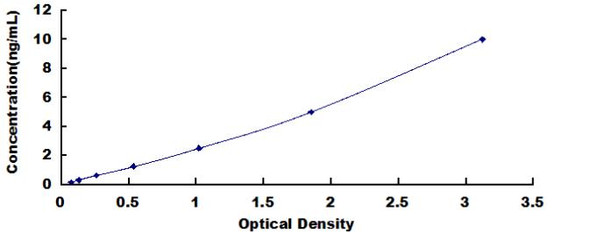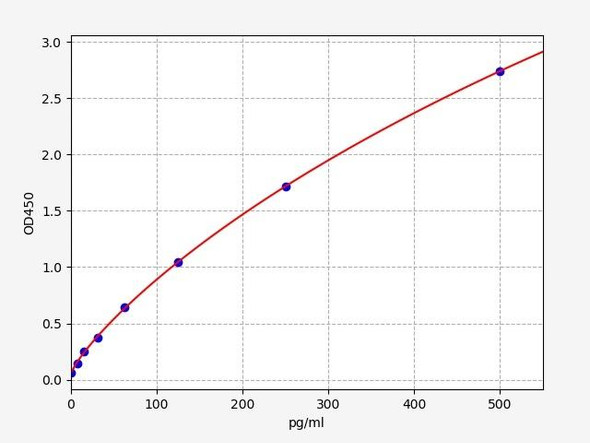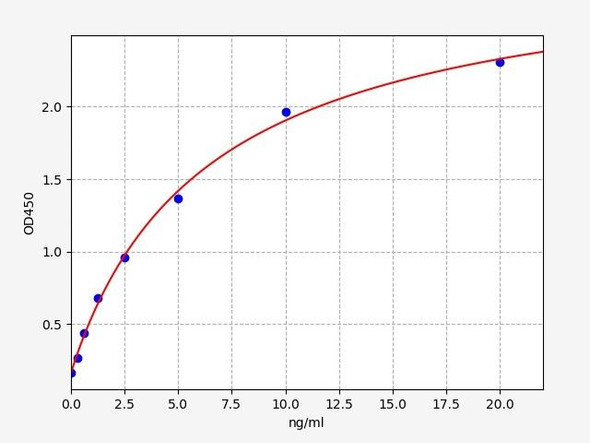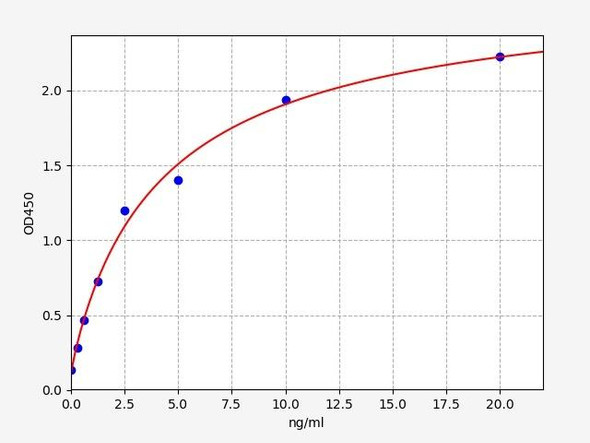Human Immunology ELISA Kits 12
Human GH (Growth Hormone) ELISA Kit (HUES01444)
- SKU:
- HUES01444
- Product Type:
- ELISA Kit
- Size:
- 96 Assays
- Uniprot:
- P01241
- Sensitivity:
- 46.88pg/mL
- Range:
- 78.13-5000pg/mL
- ELISA Type:
- Sandwich
- Synonyms:
- GH1, GH-N, GHN, hGH-N, Somatotropin
- Reactivity:
- Human
- Sample Type:
- Serum, plasma and other biological fluids
Description
| Assay type: | Sandwich |
| Format: | 96T |
| Assay time: | 4.5h |
| Reactivity: | Human |
| Detection Method: | Colormetric |
| Detection Range: | 78.13-5000 pg/mL |
| Sensitivity: | 46.88 pg/mL |
| Sample Volume Required Per Well: | 100µL |
| Sample Type: | Serum, plasma and other biological fluids |
| Specificity: | This kit recognizes Human GH in samples. No significant cross-reactivity or interference between Human GH and analogues was observed. |
This ELISA kit uses Sandwich-ELISA as the method. The micro ELISA plate provided in this kit has been pre-coated with an antibody specific to Human GH. Standards or samples are added to the appropriate micro ELISA plate wells and combined with the specific antibody. Then a biotinylated detection antibody specific for Human GH and Avidin-Horseradish Peroxidase (HRP) conjugate are added to each micro plate well successively and incubated. Free components are washed away. The substrate solution is added to each well. Only those wells that contain Human GH, biotinylated detection antibody and Avidin-HRP conjugate will appear blue in color. The enzyme-substrate reaction is terminated by adding Stop Solution and the color turns yellow. The optical density (OD) is measured spectrophotometrically at a wavelength of 450 nm ± 2 nm. The OD value is proportional to the concentration of Human GH. The concentration of Human GH in samples can be calculated by comparing the OD of the samples to the standard curve.
| UniProt Protein Function: | GH: Plays an important role in growth control. Its major role in stimulating body growth is to stimulate the liver and other tissues to secrete IGF-1. It stimulates both the differentiation and proliferation of myoblasts. It also stimulates amino acid uptake and protein synthesis in muscle and other tissues. Defects in GH1 are a cause of growth hormone deficiency isolated type 1A (IGHD1A); also known as pituitary dwarfism I. IGHD1A is an autosomal recessive deficiency of GH which causes short stature. IGHD1A patients have an absence of GH with severe dwarfism and often develop anti-GH antibodies when given exogenous GH. Defects in GH1 are a cause of growth hormone deficiency isolated type 1B (IGHD1B); also known as dwarfism of Sindh. IGHD1B is an autosomal recessive deficiency of GH which causes short stature. IGHD1B patients have low but detectable levels of GH. Dwarfism is less severe than in IGHD1A and patients usually respond well to exogenous GH. Defects in GH1 are the cause of Kowarski syndrome (KWKS); also known as pituitary dwarfism VI. Defects in GH1 are a cause of growth hormone deficiency isolated type 2 (IGHD2). IGHD2 is an autosomal dominant deficiency of GH which causes short stature. Clinical severity is variable. Patients have a positive response and immunologic tolerance to growth hormone therapy. Belongs to the somatotropin/prolactin family. 4 isoforms of the human protein are produced by alternative splicing. |
| UniProt Protein Details: | Protein type:Secreted; Secreted, signal peptide; Hormone Chromosomal Location of Human Ortholog: 17q24. 2 Cellular Component: extracellular space; extracellular region Molecular Function:protein binding; growth hormone receptor binding; growth factor activity; prolactin receptor binding; hormone activity; metal ion binding Biological Process: positive regulation of phosphoinositide 3-kinase cascade; positive regulation of insulin-like growth factor receptor signaling pathway; positive regulation of MAP kinase activity; positive regulation of peptidyl-tyrosine phosphorylation; positive regulation of tyrosine phosphorylation of Stat5 protein; positive regulation of receptor internalization; positive regulation of JAK-STAT cascade; glucose transport; positive regulation of multicellular organism growth; JAK-STAT cascade; response to estradiol stimulus; positive regulation of tyrosine phosphorylation of Stat3 protein Disease: Isolated Growth Hormone Deficiency, Type Ia; Isolated Growth Hormone Deficiency, Type Ib; Isolated Growth Hormone Deficiency, Type Ii; Kowarski Syndrome |
| NCBI Summary: | The protein encoded by this gene is a member of the somatotropin/prolactin family of hormones which play an important role in growth control. The gene, along with four other related genes, is located at the growth hormone locus on chromosome 17 where they are interspersed in the same transcriptional orientation; an arrangement which is thought to have evolved by a series of gene duplications. The five genes share a remarkably high degree of sequence identity. Alternative splicing generates additional isoforms of each of the five growth hormones, leading to further diversity and potential for specialization. This particular family member is expressed in the pituitary but not in placental tissue as is the case for the other four genes in the growth hormone locus. Mutations in or deletions of the gene lead to growth hormone deficiency and short stature. [provided by RefSeq, Jul 2008] |
| UniProt Code: | P01241 |
| NCBI GenInfo Identifier: | 134703 |
| NCBI Gene ID: | 2688 |
| NCBI Accession: | P01241. 2 |
| UniProt Related Accession: | P01241 |
| Molecular Weight: | 22. 3 |
| NCBI Full Name: | Somatotropin |
| NCBI Synonym Full Names: | growth hormone 1 |
| NCBI Official Symbol: | GH1 |
| NCBI Official Synonym Symbols: | GH; GHN; GH-N; GHB5; IGHD2; hGH-N; IGHD1A; IGHD1B |
| NCBI Protein Information: | somatotropin |
| UniProt Protein Name: | Somatotropin |
| UniProt Synonym Protein Names: | Growth hormone; GH; GH-N; Growth hormone 1; Pituitary growth hormone |
| Protein Family: | Growth hormone |
| UniProt Gene Name: | GH1 |
| UniProt Entry Name: | SOMA_HUMAN |
As the OD values of the standard curve may vary according to the conditions of the actual assay performance (e. g. operator, pipetting technique, washing technique or temperature effects), the operator should establish a standard curve for each test. Typical standard curve and data is provided below for reference only.
| Concentration (pg/mL) | O.D | Average | Corrected |
| 5000 | 2.489 2.491 | 2.49 | 2.428 |
| 2500 | 1.769 1.777 | 1.773 | 1.711 |
| 1250 | 0.975 0.961 | 0.968 | 0.906 |
| 625 | 0.502 0.512 | 0.507 | 0.445 |
| 312.5 | 0.304 0.288 | 0.296 | 0.234 |
| 156.25 | 0.18 0.166 | 0.173 | 0.111 |
| 78.13 | 0.115 0.121 | 0.118 | 0.056 |
| 0 | 0.057 0.067 | 0.062 | -- |
Precision
Intra-assay Precision (Precision within an assay): 3 samples with low, mid range and high level Human GH were tested 20 times on one plate, respectively.
Inter-assay Precision (Precision between assays): 3 samples with low, mid range and high level Human GH were tested on 3 different plates, 20 replicates in each plate.
| Intra-assay Precision | Inter-assay Precision | |||||
| Sample | 1 | 2 | 3 | 1 | 2 | 3 |
| n | 20 | 20 | 20 | 20 | 20 | 20 |
| Mean (pg/mL) | 260.50 | 733.10 | 2028.80 | 238.50 | 668.30 | 2208.90 |
| Standard deviation | 14.30 | 40.30 | 87.20 | 13.60 | 35.40 | 114.90 |
| C V (%) | 5.49 | 5.50 | 4.30 | 5.70 | 5.30 | 5.20 |
Recovery
The recovery of Human GH spiked at three different levels in samples throughout the range of the assay was evaluated in various matrices.
| Sample Type | Range (%) | Average Recovery (%) |
| Serum (n=5) | 92-105 | 99 |
| EDTA plasma (n=5) | 94-106 | 100 |
| Cell culture media (n=5) | 88-99 | 94 |
Linearity
Samples were spiked with high concentrations of Human GH and diluted with Reference Standard & Sample Diluent to produce samples with values within the range of the assay.
| Serum (n=5) | EDTA plasma (n=5) | Cell culture media (n=5) | ||
| 1:2 | Range (%) | 87-99 | 97-113 | 97-113 |
| Average (%) | 94 | 104 | 105 | |
| 1:4 | Range (%) | 99-114 | 85-98 | 94-109 |
| Average (%) | 106 | 92 | 100 | |
| 1:8 | Range (%) | 101-118 | 79-92 | 95-106 |
| Average (%) | 107 | 86 | 100 | |
| 1:16 | Range (%) | 98-113 | 87-101 | 97-112 |
| Average (%) | 106 | 93 | 103 |
An unopened kit can be stored at 4°C for 1 month. If the kit is not used within 1 month, store the items separately according to the following conditions once the kit is received.
| Item | Specifications | Storage |
| Micro ELISA Plate(Dismountable) | 8 wells ×12 strips | -20°C, 6 months |
| Reference Standard | 2 vials | |
| Concentrated Biotinylated Detection Ab (100×) | 1 vial, 120 µL | |
| Concentrated HRP Conjugate (100×) | 1 vial, 120 µL | -20°C(shading light), 6 months |
| Reference Standard & Sample Diluent | 1 vial, 20 mL | 4°C, 6 months |
| Biotinylated Detection Ab Diluent | 1 vial, 14 mL | |
| HRP Conjugate Diluent | 1 vial, 14 mL | |
| Concentrated Wash Buffer (25×) | 1 vial, 30 mL | |
| Substrate Reagent | 1 vial, 10 mL | 4°C(shading light) |
| Stop Solution | 1 vial, 10 mL | 4°C |
| Plate Sealer | 5 pieces | |
| Product Description | 1 copy | |
| Certificate of Analysis | 1 copy |
- Set standard, test sample and control (zero) wells on the pre-coated plate and record theirpositions. It is recommended to measure each standard and sample in duplicate. Note: addall solutions to the bottom of the plate wells while avoiding contact with the well walls. Ensuresolutions do not foam when adding to the wells.
- Aliquot 100 µL of standard solutions into the standard wells.
- Add 100 µL of Sample / Standard dilution buffer into the control (zero) well.
- Add 100 µL of properly diluted sample (serum, plasma, tissue homogenates and otherbiological fluids) into test sample wells.
- Cover the plate with the sealer provided in the kit and incubate for 90 min at 37 °C.
- Aspirate the liquid from each well, do not wash. Immediately add 100 µL of BiotinylatedDetection Ab working solution to each well. Cover the plate with a plate seal and gently mix. Incubate for 1 hour at 37 °C.
- Aspirate or decant the solution from the plate and add 350 µL of wash buffer to each welland incubate for 1-2 minutes at room temperature. Aspirate the solution from each well andclap the plate on absorbent filter paper to dry. Repeat this process 3 times. Note: a microplatewasher can be used in this step and other wash steps.
- Add 100 µL of HRP Conjugate working solution to each well. Cover with a plate seal andincubate for 30 min at 37 °C.
- Aspirate or decant the solution from each well. Repeat the wash process for five times asconducted in step 7.
- Add 90 µL of Substrate Reagent to each well. Cover with a new plate seal and incubate forapproximately 15 min at 37 °C. Protect the plate from light. Note: the reaction time can beshortened or extended according to the actual color change, but not by more than 30min.
- Add 50 µL of Stop Solution to each well. Note: Adding the stop solution should be done inthe same order as the substrate solution.
- Determine the optical density (OD value) of each well immediately with a microplate readerset at 450 nm.






